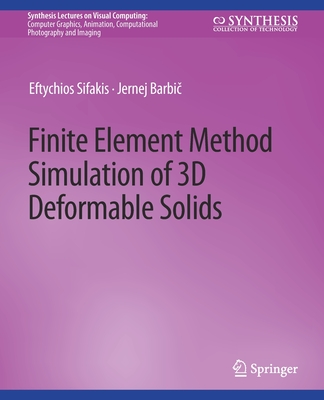You are here
Back to topFinite Element Method Simulation of 3D Deformable Solids (Synthesis Lectures on Visual Computing: Computer Graphics) (Paperback)
$36.39
Usually Ships in 1-5 Days
(This item cannot be returned.)
(This item cannot be returned.)
Description
This book serves as a practical guide to simulation of 3D deformable solids using the Finite Element Method (FEM). It reviews a number of topics related to the theory and implementation of FEM approaches: measures of deformation, constitutive laws of nonlinear materials, tetrahedral discretizations, and model reduction techniques for real-time simulation. Simulations of deformable solids are important in many applications in computer graphics, including film special effects, computer games, and virtual surgery. The Finite Element Method has become a popular tool in many such applications. Variants of FEM catering to both offline and real-time simulation have had a mature presence in computer graphics literature. This book is designed for readers familiar with numerical simulation in computer graphics, who would like to obtain a cohesive picture of the various FEM simulation methods available, their strengths and weaknesses, and their applicability in various simulation scenarios. The book is also a practical implementation guide for the visual effects developer, offering a lean yet adequate synopsis of the underlying mathematical theory. Chapter 1 introduces the quantitative descriptions used to capture the deformation of elastic solids, the concept of strain energy, and discusses how force and stress result as a response to deformation. Chapter 2 reviews a number of constitutive models, i.e., analytical laws linking deformation to the resulting force that has successfully been used in various graphics-oriented simulation tasks. Chapter 3 summarizes how deformation and force can be computed discretely on a tetrahedral mesh, and how an implicit integrator can be structured around this discretization. Finally, chapter 4 presents the state of the art in model reduction techniques for real-time FEM solid simulation and discusses which techniques are suitable for which applications. Topics discussed in this chapter include linear modal analysis, modal warping, subspace simulation, and domain decomposition.
About the Author
Eftychios Sifakis is an Assistant Professor of Computer Sciences and (by courtesy) Mechanical Engineering and Mathematics at the University of Wisconsin-Madison. He obtained his Ph.D. degree in Computer Science (2007) from Stanford University. Between 2007-2010 he was a postdoctoral researcher in the University of California, Los Angeles, with a joint appointment in Computer Science and Mathematics. His research focuses on scientific computing, physics-based modeling and computer graphics. He is particularly interested in biomechanical modeling for applications such as character animation, medical simulations, and virtual surgical environments. Eftychios has served as a research consultant with Intel Corporation, Walt Disney Animation Studios, and SimQuest LLC, and is a co-founder of the Wisconsin Applied Computing Center and recipient of the NSF CAREER award.Jernej Barbic is an associate professor of computer science at University of Southern California. In 2011, MIT Technology Reviewnamed him one of the Top 35 Innovators under the age of 35 in the world (TR35). Jernejs research interests include nonlinear solid deformation modeling, model reduction, collision detection and contact, optimal control, and interactive design of deformations and animations. He is the author of Vega FEM, an efficient free C/C++ software physics library for deformable object simulation. Jernej is a Sloan Fellow (2014).
